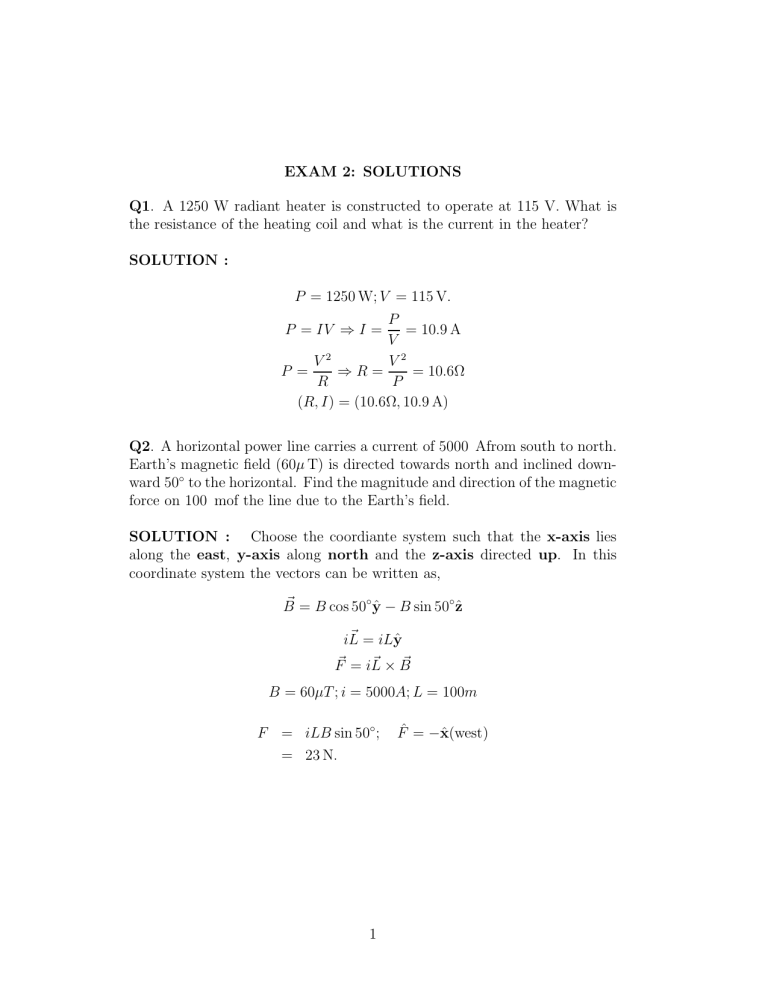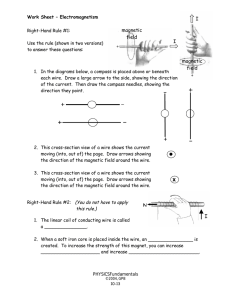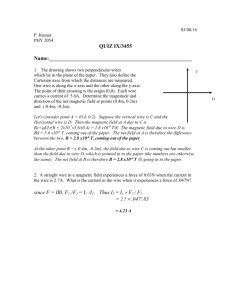EXAM 2: SOLUTIONS Q1 SOLUTION : Q2
advertisement

EXAM 2: SOLUTIONS Q1. A 1250 W radiant heater is constructed to operate at 115 V. What is the resistance of the heating coil and what is the current in the heater? SOLUTION : P = 1250 W; V = 115 V. P = 10.9 A V V2 V2 ⇒R= = 10.6Ω P = R P (R, I) = (10.6Ω, 10.9 A) P = IV ⇒ I = Q2. A horizontal power line carries a current of 5000 Afrom south to north. Earth’s magnetic field (60µ T) is directed towards north and inclined downward 50◦ to the horizontal. Find the magnitude and direction of the magnetic force on 100 mof the line due to the Earth’s field. SOLUTION : Choose the coordiante system such that the x-axis lies along the east, y-axis along north and the z-axis directed up. In this coordinate system the vectors can be written as, ~ = B cos 50◦ ŷ − B sin 50◦ ẑ B ~ = iLŷ iL ~ ×B ~ F~ = iL B = 60µT ; i = 5000A; L = 100m F = iLB sin 50◦ ; = 23 N. 1 F̂ = −x̂(west) Q3. A long straight wire carries a current i1 = 30 A, and a rectangular loop carries currenti2 = 20 A. The loop is 30 cm long and 8 cm on the side. Its side nearest to the wire is 1 cm from the wire. What is the net force on the loop due to i1 ? SOLUTION : The magnetic field along the two sides of the loop that are perpendicular to the wire is same but the direction of current is opposite. So they experience similar forces in opposing directions, meaning that there is no net force along the horizontal direction. The sides of the loop that are parallel to the wire are at different distances from the wire and so have different magnetic fields along them. The field is stronger along the side closer to the wire and the field is weaker along the side that is farther away from the wire. Let us label the side that is closer to the wire as AB and the one farther away from the wire as CD. Let d0 be the closest distance of the wire from the loop and x, the loop breadth. µ0 i1 i2 L ~ µ0 i1 i2 L F~AB = ŷ ŷ; FCD = − 2πd0 2π(d0 + x) i1 = 30 A; i2 = 20 A; L = 30 cm; d0 = 1 cm; x = 8 cm. F~net = F~AB − F~CD " # µ0 i1 i2 L 1 1 ŷ = − 2π d0 (d0 + x) = (3.2 × 10−3 N)ŷ Q4. A certain capacitor has a capacitance of 5.0µ F. After it is charged to 5.0µ C and isolated, the plates are brought closer together so its capacitance becomes 10µ F. The work done by the agent is about : SOLUTION : Q = 5.0µ C; Ci = 5.0µ F; Cf = 10.0µ F 1 Q2 U = CV 2 = 2 2C 2 ∆W = ∆U = Uf − Ui " # Q2 1 1 = − 2 Cf Ci = −1.25 × 10−6 J. Q5. The switch is closed at time t = 0 to begin charging an initially uncharged capacitor of C = 15µ F, through a resistor R = 20Ω. At what time is the potential across the capacitor equal to the one across the resistor? SOLUTION : The expressions for the current i through the RC circuit and the voltage across the capacitor Vc are given in the text book(page 721). Vc = ξ (1 − exp(−t/τ )) ; VR = iR = ξ exp(−t/τ ); τ = RC R = 20Ω; C = 15µ F Vc = VR ⇒ exp(−t/τ ) = 1 ⇒t = 2 = = ' τ ln 2 RC ln 2 0.207 × 10−3 s 0.21ms Q6. A loop of wire carrying a current of 2.0 A is in the shape of a right triangle with two equal sides, each 15 cm long. A 0.7 T uniform magnetic field is parallell to the hypoteneuse. The resultant magnetic force on the two equal sides has a magnitude of : SOLUTION : For a right isosceles triangle the hypoteneuse meets both the adjuscent and opposite sides at 45◦ . That means the angle between the current element and the magnetic field is 45◦ on both the sides. Labeling the edges of the triangle A,B and C such that AB is the adjuscent side, BC the opposite side and CA the hypoteneuse ... F~AB = iLB sin 45◦ ẑ (out of the page) F~BC = −iLB sin 45◦ ẑ (in to the page) F~net = F~AB − F~BC = 0 N. 3 Q7. Five cylindrical wires are made of the same material. The lengths and radii are wire 1: length l, radius r wire 2: length l/4, radius r/2 wire 3: length l/2, radius r/2 wire 4: length l, radius r/2 wire 5: length 5l, radius 2r SOLUTION : Resistance, R = ρ Rp (wire (wire (wire (wire (wire 1)R1 2)R2 3)R3 4)R4 5)R5 L L L =ρ 2 ∝ 2 A πR R L l l/4 l/2 l 5l R2 r2 2 r /4 r 2 /4 r 2 /4 4r 2 L R2 2 l/r l/r 2 2l/r 2 4l/r 2 5 l/r2 4 R1 = R2 < R5 < R3 < R4 . Q8. Electrons(mass m, charge −e) are accelerated from rest through a po~ that is tential difference V and are then deflected by a magnetic field B perpendicular to their velocity. The radius of the resulting electron trjectory is : SOLUTION : Energy conservation condition: r Thus we get, v = 2V e m 1 mv 2 2 + ∆V = 0 ⇒ 12 mv 2 − eV = 0. . mv 2 F~c + F~B = 0 ⇒ = Bev R R= mv v = Be B me q = 4 2mV /e B Q9. Suppose the electric company charges 10 cents per kWhr. How much does it cost to use 125 Wlamp 4 hours a day for 30 days? SOLUTION : Total power consumption = 125 × 4 × 30 = 15kW h. Total charge = (Total power consumed) × (price per unit) = (15kW h) × (0.1$/kW h) = $1.5 Q10. Two long parallel straight wires carry equal currents in opposite directions. At a point midway between the wires, the magnetic field they produce is : SOLUTION : At a point midway, the magnitudes of the magnetic fields produced by the two currents are same and act along a direction which is perpendicular to the plane of the wires. Q11. When switch S is open, the ammeter in the circuit shown reads 2.0 A. When S is closed, the ammeter reading : SOLUTION : Increases slightly, because when the switch is closed the 60Ω resistor is added parallel to the 20Ω resistor reducing the effective resistance, thereby increasing the total current of the circuit. 5





